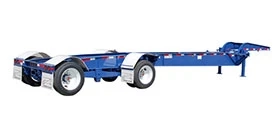ISO tank chassis and standard tank trailers are both used to transport liquids and gasses, but there are some significant differences between the two. In this blog, we will compare and contrast ISO tank chassis and standard tank trailers.
Design: ISO tank chassis are specifically designed to transport ISO tanks, which are cylindrical containers with a capacity of up to 26,000 liters. Standard tank trailers, on the other hand, come in various shapes and sizes and can transport a range of liquids and gasses.
Capacity: ISO tank chassis are designed to carry ISO tanks, which have a standard capacity of 26,000 liters. Standard tank trailers can carry a range of capacities, from a few thousand liters to over 40,000 liters.
Mobility: ISO tank chassis are designed for intermodal transport, which means they can be easily transferred from one mode of transport to another, such as from a truck to a ship or a train. Standard tank trailers are generally limited to road transport.
Safety: ISO tank chassis are designed with safety features such as anti-roll stability systems, making them less prone to accidents. Standard tank trailers may not have these safety features and may require more maintenance to ensure safety.
Efficiency: ISO tank chassis are more efficient than standard tank trailers because they can be quickly loaded and unloaded, reducing waiting times and improving turnaround times. Additionally, ISO tank chassis are designed to optimize weight distribution, reducing fuel consumption and increasing efficiency.
Cost: ISO tank chassis can be more expensive than standard tank trailers, as they are designed for a specific purpose and require specialized equipment. However, they may be more cost-effective in the long run due to their efficiency and safety features.
ISO tank chassis and standard tank trailers have their strengths and weaknesses. The choice between the two depends on the specific needs of the transport operation. While ISO tank chassis are designed for intermodal transport and have safety and efficiency advantages, standard tank trailers may be more versatile and cost-effective for certain applications.
The Importance of Choosing the Right ISO Tank Chassis for Your Cargo
ISO tank chassis are an important component in the transportation of liquids and gases, such as chemicals, fuels, and food products. Choosing the right ISO tank chassis is crucial for ensuring the safe and efficient transport of your cargo. Here are some of the reasons why choosing the right ISO tank chassis is important:
Safety: The right ISO tank chassis should be able to safely carry your cargo, reducing the risk of accidents or spills. Choosing a chassis with the correct weight capacity and safety features, such as brake systems and suspension, is essential for ensuring the safety of your cargo and the people involved in its transportation.
Compatibility: ISO tank chassis come in various sizes and configurations. Choosing the right chassis that is compatible with your specific ISO tank container is important to ensure that your cargo fits securely and is transported safely.
Efficiency: The right ISO tank chassis should be able to transport your cargo efficiently, reducing the time and costs associated with transportation. For example, a chassis with a low tare weight can help increase the payload capacity of your cargo, allowing you to transport more goods in fewer trips.
Regulations: Different countries and regions have different regulations and standards for ISO tank chassis. Choosing a chassis that meets the regulations and standards in your area is important to avoid any legal or regulatory issues.
In summary, choosing the right ISO tank chassis is critical to ensure the safe and efficient transportation of your cargo. It is important to consider factors such as safety, compatibility, efficiency, and regulations when selecting an ISO tank chassis.


